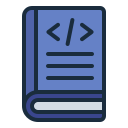
Introduction to Programming Languages
Programming languages are the foundation upon which all software is built. They allow developers to translate complex algorithms into instructions that computers can execute. Understanding programming languages is crucial for anyone looking to explore the vast fields of software development, data science, or any technology-driven industry.
The Evolution of Programming Languages
Programming languages have their roots in the early days of computing, when pioneers developed the first machine and assembly languages to interact directly with hardware. These languages laid the groundwork for the development of more abstract programming languages, making it easier for humans to write complex programs.

Key Programming Languages of the Past
FORTRAN's Legacy
FORTRAN, one of the earliest high-level languages, was created to facilitate scientific and mathematical computations. Its introduction made it possible to handle complex numerical tasks efficiently, setting the stage for future advancements in engineering and scientific programming.
COBOL in Business
COBOL was designed specifically for business applications and data processing. Its readability and straightforward syntax allowed for widespread adoption in industries that required reliable, large-scale business data operations. COBOL systems still manage vast quantities of financial transactions worldwide.
The Influence of BASIC
BASIC played a pivotal role in making programming accessible to a wider audience. Its simple syntax and availability made it a popular choice for education, allowing students and hobbyists to experiment with programming in an interactive manner. This democratization of coding nurtured a new generation of software enthusiasts.
Python's Flexibility
Python has become one of the most popular programming languages due to its simplicity and versatility. Its clean syntax and vast library support make it a favorite among beginners and seasoned developers alike. Python’s diverse applications range from web development to data analysis and artificial intelligence.
Java's Cross-Platform Capabilities
Java stood out by promoting “write once, run anywhere” philosophy. This cross-platform feature, along with its robust security and object-oriented principles, fueled its adoption in enterprise environments, mobile application development, and large-scale systems.
JavaScript and the Web Revolution
JavaScript is integral to the dynamic nature of the modern web. It allows developers to create interactive and responsive web applications. Coupled with HTML and CSS, JavaScript powers a vast array of web technologies and frameworks, driving the evolution of digital user experiences.
Previous
Next
Practical Applications of Programming
Programming languages like HTML, CSS, JavaScript, and PHP form the backbone of web development. They enable the creation of everything from interactive web applications to dynamic online platforms, playing a vital role in the internet’s growth and evolution.
Previous
Next
Learning Programming Languages
Choosing the Right Language
Selecting the right programming language depends on various factors, including the specific application domain, community support, and available resources. Beginners should consider their goals and start with a language that offers a balance of simplicity and functionality.
Online Resources and Courses
The internet provides a wealth of resources for learning programming languages, including free tutorials, online courses, and coding boot camps. Engaging with these materials can significantly accelerate one’s learning process, offering practical experience and community insights.
Practicing through Projects
Hands-on experience is invaluable when learning to code. Developing personal or collaborative projects allows learners to apply theoretical knowledge in real-world scenarios, enhancing their problem-solving abilities and improving their coding proficiency.
Future of Programming Languages

The future of programming languages will be influenced by advancements in technology and the demand for more efficient and secure coding practices. Trends such as quantum computing, blockchain, and IoT will shape new paradigms and the evolution of existing languages.
